
1 Department of Business Administration, Aligarh Muslim University, Aligarh, Uttar Pradesh, India
Creative Commons Non Commercial CC BY-NC: This article is distributed under the terms of the Creative Commons Attribution-NonCommercial 4.0 License (http://www.creativecommons.org/licenses/by-nc/4.0/) which permits non-Commercial use, reproduction and distribution of the work without further permission provided the original work is attributed.
This study aims to identify current research trends and suggests potential areas for future investigation in the field of “luxury consumption behavior.” To achieve this, we gathered a comprehensive dataset spanning five decades, consisting of 1,289 articles from Scopus and Web of Science databases, which underwent rigorous bibliometric analyses. Our bibliometric analysis has unveiled crucial insights, including key performance indicators, emerging areas of study, significant keywords, and prevailing research themes within the luxury consumption domain. The findings emphasize the remarkable growth of luxury consumption as a research area, leading to the identification and examination of five distinct research clusters. Through this in-depth bibliometric analysis, our study enriches the existing body of knowledge on luxury consumption, offering a comprehensive overview of scholarly contributions in this field and paving the way for potential future research endeavors.
Bibliometric analysis, luxury consumption, luxury brand management, luxury consumer behavior
Introduction
The expansion of global luxury merchandise has piqued the curiosity of many researchers. Luxury brands’ consumption differs from ordinary products because it goes beyond satisfying utilitarian necessities (Dahm & Fassnacht, 2018). Luxury consumption, an integral facet of consumer behavior, pertains to acquiring and utilizing high-end products and services often associated with premium quality, exclusivity, and elevated status (Dubois et al., 2005). According to a survey commissioned by Italy’s Altagamma Foundation, the global luxury market increased by almost one-third to 288 billion euros ($198 billion), bouncing back from its lowest recorded drop owing to the pandemic lockdown (Bain & Company, 2018). Luxury consumption behavior has gained significant prominence in academic and practical domains, reflecting its profound influence on modern societies and economies (Aliyev et al., 2019). Historical records indicate that luxury consumption dates back to ancient civilizations, where possessing rare and extravagant items symbolized social standing and affluence (Rathi et al., 2022). Over time, luxury consumption has evolved from conspicuous displays of wealth to encompass more nuanced dimensions, such as self-expression (Kim & Jang, 2014), identity formation (Bhanja & Mehta, 2022), and hedonistic experiences (Shukla, 2012). The allure of luxury consumption extends beyond the tangible aspects of products and services (Fuentes et al., 2022). It encompasses intangible elements, including luxury brands’ narratives, values, and emotions (Han & Kim, 2020). Consumers often gravitate toward luxury goods for their utilitarian benefits and the aspirational and emotional connections they forge with these symbols of prestige (Park et al., 2013).
In recent decades, the landscape of luxury consumption has undergone dynamic shifts. Globalization, technological advancements, and changing social norms have reshaped how luxury is perceived and pursued (Aleem et al., 2022; Rathi et al., 2022; Shukla et al., 2022). The trend toward democratizing luxury, also known as “masstige marketing,” has expanded the accessibility of premium products to a diverse spectrum of consumers (Kumar et al., 2020). This phenomenon has increased the availability of upscale goods to a broad spectrum of consumers, encompassing both developed and emerging countries (Lim et al., 2022a). The rise of digital platforms and social media has facilitated greater accessibility to luxury brands while fostering new avenues for self-presentation and social comparison (Eastman et al., 2020; Fazeli et al., 2020). Academically, the study of luxury consumption has garnered substantial interest from various disciplines, including marketing, psychology, sociology, and economics. Scholars have sought to unravel the intricate psychological and sociocultural drivers behind luxury consumption choices, examining status consumption (Roy & Rabbanee, 2015), brand loyalty (He et al., 2010), social influence (Byun et al., 2020), and conspicuous leisure factors (Li & Stodolska, 2022).
The necessity for conducting bibliometric analysis in this field stems from the limited number of comprehensive studies that thoroughly chart and analyze the academic landscape of luxury consumption behavior. Bibliometric analysis offers a wide range of data, enabling researchers to gain insights into the patterns of publication within a specific subject area (Jain & Dhingra, 2023). More specifically, bibliometric analysis provides a quantitative methodology for evaluating scholarly contributions, identifying emerging patterns and exploring the relationships within this field as highlighted by Donthu et al. (2021a).
This research delves into the luxury consumption behavior domain to enrich the existing knowledge base through a thorough bibliometric analysis within the marketing discipline. By examining the progression of research within this domain, we aim to discern critical trends, influential authors, countries, and emerging themes. Through this analysis, we hope to shed light on the evolving landscape of luxury consumption behavior and provide valuable insights for researchers and practitioners navigating this captivating and ever-evolving field.
With this objective in mind, the current study addresses two core research questions (RQs).
We explore the aforementioned RQs using bibliometric methods to analyze the literature on “luxury consumption.” To address RQ1, we employ various performance indicators to identify growth patterns, notable articles, influential journals, authors, and contributing countries within the field, all based on bibliographic data. Moreover, we track the progression of key concepts in the “luxury consumption behavior” literature by analyzing how frequently scholars reference specific ideas in their articles across different time frames. Furthermore, our assessment involves bibliometric maps to capture the evolutionary trajectory of luxury consumption over time, aiding in anticipation of emerging trends. Finally, in response to RQ2, on the basis of cluster analysis, we propose future avenues of research and implications to expand the scope of the investigation into luxury consumption.
Contribution
This comprehensive review encompasses more than five decades of extensive literature, serving as a significant and noteworthy contribution to the field of “luxury consumption behavior.” It provides a critical and up-to-date understanding of various research aspects, reflecting a holistic approach to examining the crucial role of luxury consumption in the realm of marketing. The incorporation of bibliographic data for performance analysis, which includes growth trends, key articles, prominent journals, influential authors, and contributing countries, adds further significance to this study. Additionally, the investigation of thematic evolution, word cloud analysis, and the identification of keyword co-occurrences assist in defining five distinct clusters, offering valuable insights for future research directions to scholars in this field.
As Paul and Bhukya (2021) recommended, we enlist and explain the sequence of this review article. Subsequently, we detail the methodologies utilized in the research. We then present the findings derived from the performance analysis. Additionally, we explore the outcomes of the science mapping and outline potential directions for future research. Finally, we conclude by addressing the study’s implications and limitations.
Research Methods
As illustrated in Figure 1, our approach draws from established practices commonly employed in standard bibliometric analysis, as elucidated by Donthu et al. (2021a) in their recent study. Following their methodologies, we embraced conventional procedures to conduct a comprehensive bibliometric analysis. This approach allows us to methodically explore the intricate dimensions of scholarly literature within our chosen domain (Mukherjee et al., 2022).
Figure 1. Literature Search and Screening Criteria.
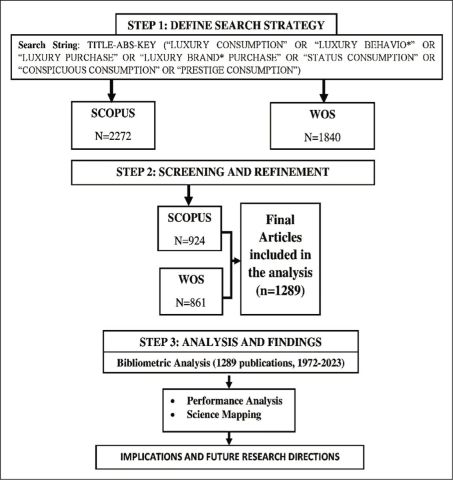
Defining the Search Strategy
A crucial and demanding phase within bibliometric analysis involves identifying pertinent research articles, which relies on establishing suitable search parameters and choosing a suitable database (Donthu et al., 2021a). We obtained documents from Scopus and Web of Science (WOS). Scopus and WOS were utilized because of their widespread popularity, breadth of coverage, and high quality (Ameen et al., 2022; Bilro & Loureiro, 2020; Dawkins et al., 2019; Mariani et al., 2018). We performed a keyword-based search within the title, abstract, and keywords (TITLE-ABS-KEY) sections until August 2023. This search was executed in August 2023, yielding 4,112 records from the Scopus (2,272 documents) and WOS (1,840 documents) databases.
Screening the Initially Retrieved Documents and Refining the Search Results
Due to considerations of understanding boundaries and upholding the study’s meticulousness, the filtering procedure incorporated explicit criteria for inclusion and exclusion (Lim et al., 2022b). First, only journal articles within the broader marketing realm and composed in English were encompassed. Second, our search scope was confined solely to journal articles, with conference papers, books, and non-peer-reviewed materials deliberately excluded from the database. Additionally, duplicate articles were eliminated through database filtration. Furthermore, the scrutiny extended to the title, keywords, abstract, and introduction segments to assess whether the emphasis revolved around “luxury consumption behavior.” Besides, even if a solitary study within an article explored the realm of luxury consumption in the marketing context, it was incorporated into the analysis. As a result of this inclusive approach, the implemented search queries effectively pinpointed a total of 1,289 documents that were published prior to August 10, 2023. This substantial dataset is a robust foundation for conducting a comprehensive bibliographic analysis, aligning with the methodology highlighted by Paul and Criado (2020).
Describing the Data Processing Procedure
Subsequently, the gathered articles underwent a thorough assessment through bibliometric and content analyses, allowing for an in-depth exploration of the evolving landscape within “luxury consumption” research. The bibliometric analysis was meticulously executed using the specialized bibliometric package within the R software framework, facilitating a comprehensive array of bibliometric computations across an extensive dataset from May 1972 to August 2023. Table 1 illustrates the descriptive statistics concerning the dataset focused on luxury consumption. This dataset comprised 1,289 peer-reviewed publications, originating from 438 distinct journals and involving contributions from 2,554 authors representing 68 countries.
Table 1. Descriptive Information of the Data on Luxury Consumption from 1972 to August 2023.

Bibliometric Analysis
In recent times, bibliometrics has emerged as a widely accepted and reputable approach for reviewing extensive collections of literature across various scientific disciplines (Ellegaard & Wallin, 2015; Linnenluecke et al., 2020; Mukherjee et al., 2022). This method reduces potential biases while managing the substantial volume of bibliographic information (Mukherjee et al., 2022). Moreover, it aids in observing the longitudinal developments within the existing literature (Donthu et al., 2021a). Furthermore, it simplifies the identification of the intellectual framework and emerging concepts (Paul & Criado, 2020). Within the bibliometric approach outlined by Cobo et al. (2011), one component, “performance analysis,” focuses on evaluating the contributions of different research elements to the field. This facet aims to pinpoint leading research components and their evolving patterns within the studied domain. The second aspect, termed “science mapping,” involves the examination of citations, collaborative authorships, and co-words found in publications. This process involves using bibliometric techniques such as bibliographic coupling, co-citation analysis, co-authorship networks, keyword frequency, and more to visually represent the interconnections within the dataset (Cobo et al., 2011).
We utilized the “bibliometrics” package within the R software framework to perform comprehensive bibliometric calculations on an extensive dataset from 1972 to 2023, comprising 1,289 publications. Additionally, we employed VOSviewer, a tool created by van Eck and Waltman (2010), which serves two primary purposes: VOS mapping and VOS clustering. This software was utilized to examine the co-occurrence of keywords and generate visual representations.
Performance Analysis
Publications Trend
Figure 2 illustrates the chronological evolution of scholarly articles addressing the topic of “luxury consumption behavior” across the Scopus and WOS databases, encompassing the years 1972–2022. The exploration of this subject initially commenced in 1972 with one publication. However, it was only after 2012 that the field began to witness a notable surge in activity, and this trend has continued to progress markedly. This progression is highlighted by the fact that in 2019, a total of 102 articles were published, a number that further increased to 122 articles by 2020 and 160 articles by the year 2022. Notably, the production of literature in this area has seen a pronounced expansion, attributed to the escalating interest and engagement among scholars and experts alike. This escalating growth is characterized by an annual growth rate of 9.53%. Moreover, Figure 3 provides a graphical representation of the annual average citation count spanning the years 1972–2022. In Table 2, we emphasize the top 10 years with the most citations, revealing that 1998 stands out as the year with the highest average citation per article, at 190.8, followed closely by 1996, which received an average of 188.67 citations, and 1989 with an average of 171 citations.
Figure 2. The Annual Publication Pattern of 1,289 Articles Collected from Scopus and Web of Science Spanning the Years 1972–2022.

Figure 3. Average Citations Per Year from 1972 to 2022.
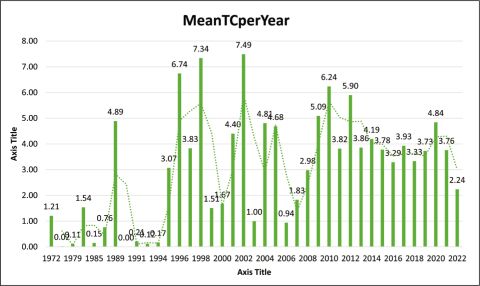
Table 2. Top 10 Mean Citation Per Article.

Publication Outlets
Table 3 illustrates the leading 10 journals demonstrating the highest publication output within this field. The analysis encompasses a total of 1,289 publications, which are spread across 438 distinct journals. It is essential to highlight that many of these journals hold prestigious ratings from the Australian Business Deans Council (ABDC), particularly A* and A designations, signifying their recognition as esteemed publications in business and management research. Among the entirety of the articles examined, a noteworthy subset of 362 articles, equivalent to 28.08% of the total, emerged from the top 10 journals. The Journal of Business Research emerges as the most prolific outlet, boasting 84 published articles. Following closely is the Journal of Retailing and Consumer Services, contributing 57 articles. Psychology & Marketing secures the third spot with 39 articles, while the Journal of Fashion Marketing and Management has featured 30 articles.
Table 3. Top 10 Leading Journals Publishing on Luxury Consumption Behavior.

Notes: TP = total publications; ABDC = ABDC is the ranking of journal quality (provided by Australian Business Deans Council), A* = highest quality showing top 5%–7% journals in the field, A = second highest quality showing the next 15%–25% journals in the field, and B = third highest quality showing the next 35%–40% journals in the field.
Most Cited Publications
The identification of the most pertinent works within the realm of “luxury consumption behavior” was carried out through an examination of the citations garnered by each individual article. Table 4 showcases the articles with the highest level of productivity in the field of luxury consumption, determined by both their total citation count (TC) and the average annual sum of citations received. According to the table’s findings, the article authored by Han et al. (2010) holds the most significant influence in this field, accumulating 813 citations and maintaining an average annual citation rate of 58.07 since its publication. This study investigates the driving factors behind luxury consumption by segmenting consumers into four categories based on their wealth and desire for social status. Preceding this work is the research conducted by Wong and Ahuvia (1998), which has been cited 589 times. This study probes into the cultural influences underpinning the luxury consumption phenomenon, mainly through comparing Southeast Asian and Western cultural contexts. Subsequently, the study authored by Wiedmann et al. (2009) cited 506 times explores a comprehensive framework for understanding luxury value as a foundational approach to identifying consumer segments based on value-related factors.
Table 4. Most Relevant Articles in Sorted by Total Citations (TC).
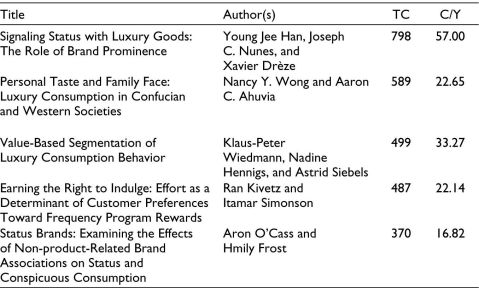
Most Prolific Author(s)
Figure 4 provides a visual representation of how influential authors have evolved over time in terms of their publishing and citation impact. The size of the bubbles in the graphic corresponds to the number of publications associated with each author, while the line graph illustrates the progression of an author’s publications over the years. The color intensity of the bubbles indicates the total yearly citations received.
Figure 4. Authors Production Overtime
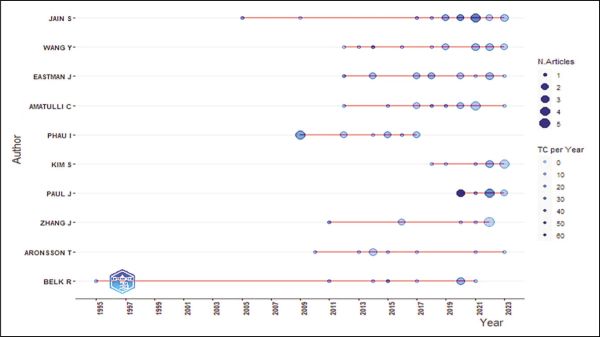
Source: Biblioshiny, authors’ elaboration.
Table 5 illustrates the primary contributors in order of their publication output. Among those who have exhibited the most significant productivity in the field of “luxury consumption behavior” are Sanjay Jain, with a total of 17 published works and 636 citations; Ying Wang, with 15 published works and 359 citations; Jacqueline K. Eastman, having authored 14 works with 456 citations; and Cesare Amatulli, whose contributions amount to 13 published works and 333 citations.
Table 5. Most Prolific Author(s) as per the Number of Publications.
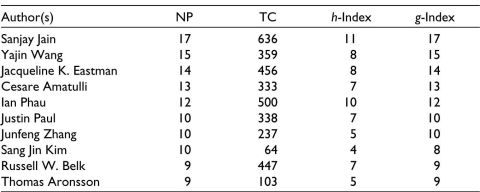
It is crucial to identify significant author networks to gain a comprehensive understanding of luxury consumption research. To achieve this, we utilized association strength normalization in combination with the Louvain cluster algorithm on the top 50 documents to form the authors’ clusters. Figure 5 illustrates the emergence of six distinct, color-coded clusters among the 25 most prolific authors. The larger nodes represent authors who have contributed more publications, while the connections between nodes are thicker for scholars who have collaborated on multiple articles. Notably, a prominent collaboration network is observed between Eastman J. and Iyer R.
Figure 5. Author(s) Collaboration.
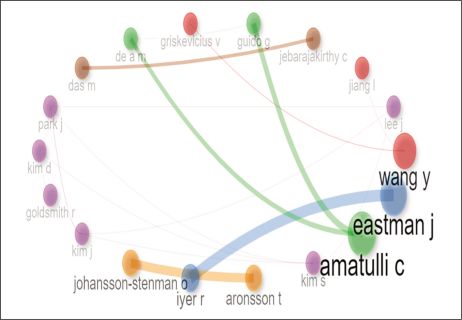
Source: Biblioshiny, authors’ elaboration.
The Scientific Production of the Countries
Examining the affiliations data reveals that the contributing organizations and institutions are spread worldwide, with a concentrated presence in countries such as the United States, China, the United Kingdom, India, and France. In Figure 6, a comprehensive overview is provided, showcasing the critical countries linked to authors engaged in the study of luxury consumption. Notably, the United States takes the lead as the foremost contributor, generating a substantial number of 619 articles. This is followed by China, which contributed significantly to 250 articles, signifying a notable scholarly involvement. Moreover, the United Kingdom has established itself as a noteworthy participant in this field, producing 210 articles contributing to the luxury consumption discourse. Additionally, India stands out with its scholarly contributions, having generated 147 articles that explore various facets of luxury consumption. This collective body of work highlights the global engagement and diverse perspectives that enrich the discourse around luxury consumption. Furthermore, Table 6 presents the leading 10 instances of international collaboration concerning behaviors related to luxury consumption.
Figure 6. Most Productive Countries in Luxury Consumption Behavior Marketing Research.
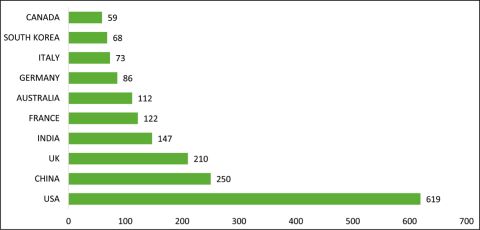
Table 6. Countries Collaboration.
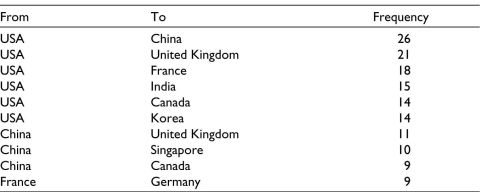
Thematic Analysis
Thematic Map
Cobo et al. (2011) explore techniques for estimating and visually representing the focus of a specific area of research. They introduce a thematic map as an effective visual tool, assessing topics within a quadrant. The thematic map is structured based on centrality (along the x-axis) and density (along the y-axis). Density signifies the level of development of a chosen theme, while centrality gauges the significance of the central theme. This thematic map is divided into four sections. Themes positioned in the lower-left quadrant indicate either declining or emerging subjects. These themes either fade from research or are further developed by researchers. Themes in the lower-right quadrant represent foundational concepts that have undergone extensive research. In contrast, the upper-left quadrant showcases niche concepts developed but in relative isolation. Finally, themes in the upper-right quadrant indicate well-developed and established research areas.
Upon carefully examining the map (as shown in Figure 7), it becomes evident that “luxury consumption, sustainability, and luxury branding” form highly developed and isolated themes within the literature, characterized by internal solid connections. However, their significance in this research is limited due to their sparse connections with other themes. On the other hand, themes such as social media, brand equity, and masstige exhibit weaker development, featuring lower density and centrality. Conversely, themes such as status consumption, materialism, social comparison, and luxury brands emerge as the most well-developed and crucial elements in shaping the landscape of luxury consumption behavior research. These themes are pivotal because of their significant field progress and frequent appearances in various research studies.
Figure 7. Thematic Map of Luxury Consumption Behavior Scholarship.
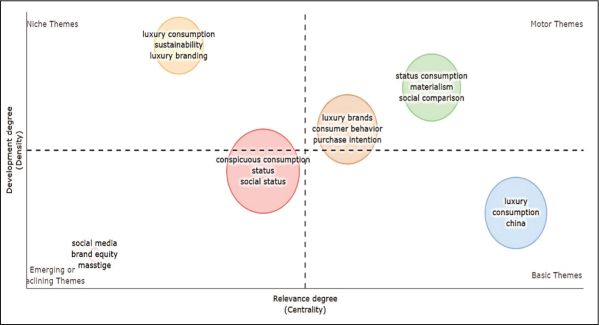
Source: Biblioshiny, authors’ elaboration.
Thematic Evolution
The progression of themes in a particular research domain can be depicted using alluvial graphs that segment the timeline into distinct periods (Aria et al., 2022). Analyzing the yearly distribution of publications, the data collection is segmented into four-time intervals, achieved by establishing three breakpoints in 2013, 2017, and 2019. Through the segmentation of the examined timeframe into distinct intervals, it becomes feasible to examine the progression of each theme (Donthu et al., 2020). A longitudinal visualization offers valuable insights into the inclinations of specific topics to converge with other themes or diverge into multiple new themes throughout the study, as demonstrated in Figure 8.
Figure 8. Thematic Evolution of Luxury Consumption Behavior Scholarship.
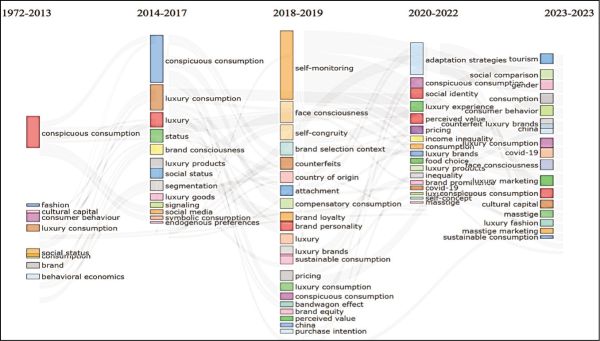
Source: Biblioshiny, authors’ elaboration.
From 1972 to 2013, significant keywords that gained prominence included conspicuous consumption, consumer behavior, and luxury consumption. From 2014 to 2017, researchers delving into “luxury consumption behavior” underwent a noticeable shift in their focus, placing greater importance on conspicuous consumption, luxury consumption, luxury, status, brand consciousness, and luxury products. Between 2018 and 2019, there was an evident change in the research direction towards various domains, including self-monitoring, face consciousness, counterfeit, and brand selection. From 2022 to August 2023, noteworthy areas of interest have emerged, covering topics such as adaption strategies, perceived value, social identity, and luxury experience.
Word Cloud
Word clouds serve as a visual representation technique for text data, highlighting the most frequently occurring words to provide a quick overview (Baker et al., 2021). Figure 9 clearly demonstrates that the primary keywords utilized by the author(s) in the chosen studies prominently include conspicuous consumption, luxury consumption, status-oriented consumption, and materialism. This word cloud provides compelling evidence that research in the realm of luxury consumption places significant emphasis on topics such as conspicuous consumption, the need for status, and materialistic tendencies.
Figure 9. Word Cloud of the Most Prominent Author Keywords.
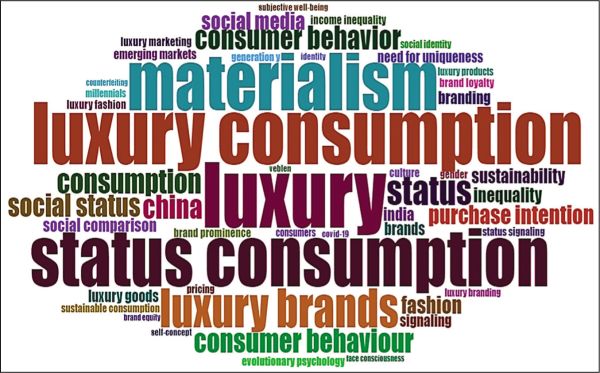
Source: Biblioshiny, authors’ elaboration.
Cluster Analysis
Data clustering is a technique used to gather a collection of articles. In the resultant network, nodes can be organized into clusters so that the links between nodes within the same cluster are more abundant than those between nodes in different clusters (Husain et al., 2022c). An essential advantage of this analysis is its ability to discern subfields within the research theme, which can be further identified by thoroughly examining the papers within specific clusters.
In this section, we have conducted an examination of terms used in the realm of luxury consumption research. We generated a term “co-occurrence network map” on the basis of a dataset comprising 1,289 studies related to luxury consumption, encompassing a total of 5,001 keywords. We established a minimum threshold of five occurrences for the keywords to ensure the analysis yielded meaningful results. Among the 5,001 keywords, 200 keywords satisfied our predetermined threshold. Figure 10, generated by VOSviewer, displays the formation of five distinct clusters. Nodes sharing the same color on the map are part of the same cluster, and the proximity between nodes within the cluster signifies their relationship’s strength.
Figure 10. Co-occurrence and Network of Author(s) Keywords.

Source: VOSviewer, authors’ elaboration.
Cluster 1 # Luxury Consumption and Materialism
The relationship between luxury consumption and materialism has long been a subject of academic inquiry and societal debate. Luxury consumption involves purchasing and possessing high-end products or experiences, often linked to social status and exclusivity (Donthu et al., 2021b). Conversely, materialism refers to the pursuit of possessions and wealth as a source of life satisfaction (Kim et al., 2022). Numerous studies have explored the connection between luxury consumption and materialism (Hudders, 2012; Sundie et al., 2020). However, the relationship between luxury consumption and materialism is complex and only partially one dimensional (de Kerviler & Rodriguez, 2019). While luxury goods can offer esthetic pleasure and enhance self-esteem (Hudders et al., 2013). However, they can fuel materialistic tendencies as individuals seek to project their success and identity through possessions (Bhanja & Mehta, 2022). Research suggests that individuals may engage in luxury consumption for a variety of reasons, including personal enjoyment (Smit, 2022), appreciation for craftsmanship (Kapferer & Valette-Florence, 2021), and a desire to share meaningful experiences with loved ones (Shahid & Paul, 2021). In conclusion, the relationship between luxury consumption and materialism is multifaceted (Duma, 2022). While luxury consumption can exacerbate materialistic tendencies, it is not the sole determinant of such behavior (Hemetsberger et al., 2012). By recognizing the diverse motivations behind luxury consumption and promoting values beyond material possessions, future researchers can navigate a more balanced approach to consumption and well-being.
Cluster 2 # Conspicuous Consumption and Signaling
Conspicuous consumption, a term coined by economist Thorstein Veblen, refers to purchasing and displaying luxury goods and services primarily to signal one’s social status and wealth (Patsiaouras & Fitchett, 2012). This behavior is closely intertwined with signaling, a mechanism through which individuals communicate their attributes or qualities to others (Wang, 2022). Conspicuous consumption serves as a potent signaling tool in modern consumer societies (Bradshaw et al., 2020). By showcasing expensive possessions, individuals convey their economic prosperity and their membership in elite social circles (Han et al., 2010). Vohs et al. (2006) demonstrates the correlation between conspicuous consumption and signaling, revealing that luxury goods function as effective status symbols, facilitating social interactions and signaling personal success. Furthermore, Han et al. (2010) delve into the psychological mechanisms driving conspicuous consumption, shedding light on how such behavior fulfills individuals’ need for social recognition and identity establishment. Drawing from insights into evolutionary psychology, conspicuous consumption reflects the age-old human inclination to signal desirable traits for mate selection and social integration (Griskevicius & Kenrick, 2013). Today, it manifests as a manifestation of this intrinsic tendency, facilitating connections, attracting mates, and gaining social approval (Chan, 2015). Future research should explore the evolving dynamics of conspicuous consumption and signaling in the digital age, where social media platforms offer new avenues for status display (Sogo & Matsubayashi, 2021). Additionally, investigating cultural variations in conspicuous consumption can show how signaling mechanisms differ across societies (Awanis et al., 2017).
Cluster 3 # Consumer Behavior and Sustainability
The intersection of luxury consumer behaviors and sustainability has gained significant attention in recent years as society becomes increasingly concerned about environmental and social impacts. References indicate that luxury brands adopting sustainability initiatives enhance their reputations and attract environmentally conscious consumers (Tofighi et al., 2020). Research by Amatulli et al. (2018) shows that consumers are willing to pay more for sustainable products, a trend likely to resonate with luxury consumers. Moreover, the rise of the circular economy and second-hand luxury market highlights changing consumer attitudes toward longevity and value retention (Lou et al., 2022). Future research should explore the intricacies of luxury consumers’ motivations and the effectiveness of sustainable practices in shaping their behaviors (Alghanim & Ndubisi, 2022). Investigating the role of social media, peer influence, and cultural factors on luxury sustainability adoption could yield valuable insights. Additionally, assessing the long-term impact of sustainable luxury consumption on brand loyalty and market dynamics is a promising avenue for exploration.
Cluster 4 # Luxury Brands and Perception
Luxury consumption—a complex phenomenon rooted in social, psychological, and cultural factors—is intricately tied to perception (Purohit & Radia, 2022). How do individuals perceive luxury goods and their consumption shapes their attitudes and behaviors (Husain et al., 2022b)? Previous research indicates that consumers’ perceptions of luxury goods can influence their self-esteem, social identity, and aspirations (So et al., 2018). Furthermore, the perception of luxury can vary across cultures and generations, reflecting the evolving nature of luxury consumption (Xiang et al., 2019). Future research directions in this field could delve into the role of digital platforms and social media in investigating how luxury brands can leverage online spaces to enhance their perceived value and authenticity (Maman Larraufie & Kourdoughli, 2014). Additionally, understanding how sustainable practices influence luxury perception and whether eco-consciousness can become a marker of luxury is a compelling area for study (Pantano & Stylos, 2020). As consumer preferences and societal values evolve, continued research into luxury perception will provide crucial insights into the dynamics of consumer behavior and the changing landscape of luxury consumption.
Cluster 5 # Bandwagon and Snob Consumption
Luxury consumption, a hallmark of conspicuous wealth and status, is influenced by two contrasting psychological phenomena: the bandwagon effect and the snob effect (Kastanakis & Balabanis, 2014). The bandwagon effect propels individuals toward luxury goods as they seek to conform and align with prevailing trends, perceiving ownership as a means to social acceptance and inclusion (Eastman & Eastman, 2015). In contrast, the snob effect drives individuals to embrace luxury to distinguish themselves from the masses, valuing exclusivity and uniqueness (Kastanakis & Balabanis, 2014). Exploring how luxury brands strategically navigate these psychological influences, whether by fostering a sense of belonging or cultivating exclusivity, would provide valuable insights. Additionally, investigating the impact of cultural and generational factors on these behaviors could shed light on evolving consumer preferences. Understanding the interplay between these tendencies and their implications for marketing strategies and societal well-being becomes increasingly important as the consumer landscape evolves.
Future Research Avenues
In this section, we will focus on illuminating the gaps in the current body of literature within each cluster, with a particular emphasis on providing suggestions for future research avenues. Table 7 summarizes the potential avenues for future research within each cluster
Table 7. Future Research Avenues Within Each Cluster.
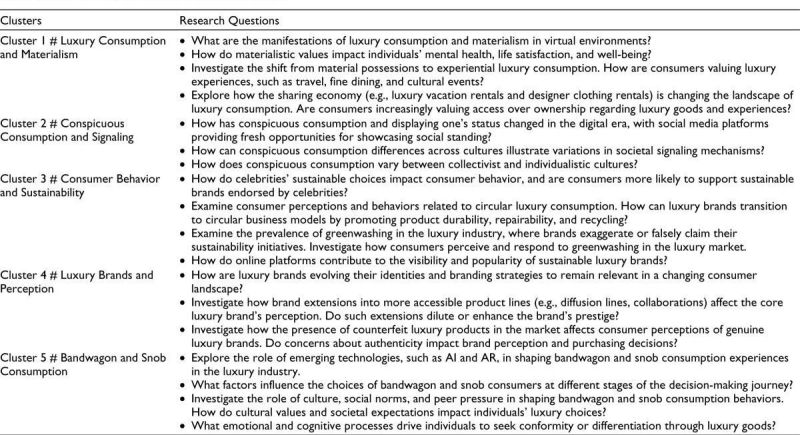
Cluster 1 # Luxury Consumption and Materialism
Over the past five years, there have been notable advancements in the study of luxury consumption and materialism. However, there is still room for further improvement in this area. As Duma (2022) pointed out, the relationship between luxury consumption and materialism is complex. While luxury consumption can contribute to materialistic tendencies, it is important to note that it is not the sole factor influencing such behavior (Hemetsberger et al., 2012). Future researchers should acknowledge the diverse motivations behind luxury consumption and promote values beyond material possessions to foster a more balanced approach to consumption and well-being.
Commercial sharing systems are evolving into a significant business concept within the luxury sector, offering access to product advantages without the need for ownership (Akbar et al., 2016). It would be valuable to investigate how the sharing economy, including services such as luxury vacation rentals and designer clothing rentals, is reshaping the landscape of luxury consumption. Additionally, the concept of anthropomorphism is of great significance in the context of luxury fashion consumption (Khan et al., 2023). Subsequent research in this field should aim to better understand how brand anthropomorphism impacts luxury consumption, influencing emotional connections, identity representation, brand loyalty, and perceptions of value.
Cluster 2 # Conspicuous Consumption and Signaling
Conspicuous consumption has always been closely linked with the concept of signaling. In contemporary society, it continues to serve as an expression of this inherent tendency, facilitating social connections, attracting potential partners, and garnering social approval (Baker et al., 2020; Chan, 2015; Sundie et al., 2020). Future research should delve into the evolving dynamics of conspicuous consumption and signaling in the digital era, where social media platforms offer new avenues for displaying one’s status (Sogo & Matsubayashi, 2021). Furthermore, the exploration of cultural differences in conspicuous consumption can provide insights into how signaling mechanisms vary across different societies (Awanis et al., 2017; Kastanakis & Balabanis, 2012). Subsequent studies should investigate extreme individualistic cultures, such as the United States, and collectivist cultures, like those found in Asia, to examine whether cultural factors contribute to the differences in conspicuous consumption.
Cluster 3 # Consumer Behavior and Sustainability
The intersection of luxury consumer behaviors and sustainability has garnered significant attention in recent years, driven by society’s growing concern for environmental and social impacts. As demonstrated in research by Amatulli et al. (2018), consumers are increasingly willing to pay a premium for sustainable products, a trend that is likely to resonate with luxury consumers. Furthermore, the emergence of the circular economy and the flourishing second-hand luxury market underscores shifting consumer attitudes toward durability and the retention of value (Christodoulides et al., 2021; Morales & Belmonte-Urena, 2021). Future research should delve deeper into the intricacies of luxury consumers’ motivations and the effectiveness of sustainable practices in shaping their behaviors, as suggested by Alghanim and Ndubisi (2022). Within this context, online communities and forums centered around luxury consumption and fashion provide individuals with platforms to share information about their acquisitions and engage in meaningful discussions (Anas et al., 2023). An examination of the influence of social media, peer interactions, and cultural factors on the adoption of sustainable luxury consumption could yield valuable insights.
Cluster 4 # Luxury Brands and Perception
Luxury consumption—a multifaceted phenomenon shaped by social, psychological, and cultural influences—is closely intertwined with the concept of perception (Nobre et al., 2022; Purohit & Radia, 2022). Examining how luxury brands adapt their identities and branding strategies to remain relevant in an evolving consumer landscape can offer valuable insights. Brands frequently expand their established brands to introduce new products, leveraging the equity established by the parent brand in the market (Bhanja & Mehta, 2022). Future research should explore the impact of such brand extensions into more accessible product lines (e.g., diffusion lines and collaborations) on the perception of the core luxury brand and how these extensions either diminish or enhance the brand’s prestige.
Additionally, brand authenticity has become a fundamental asset in contemporary marketing, but there is ambiguity surrounding the definition and application of this concept (Södergren, 2021; Wang et al., 2019). Subsequent research should investigate the influence of counterfeit luxury products and concerns about authenticity on brand perception and purchasing decisions.
Cluster 5 # Bandwagon and Snob Consumption
Luxury consumption, a symbol of conspicuous wealth and social status, is under the influence of two contrasting psychological phenomena: the bandwagon effect and the snob effect, as demonstrated by Kastanakis and Balabanis (2014). Examining how luxury brands strategically navigate these psychological influences, whether by fostering a sense of inclusion or cultivating exclusivity, holds significant potential for gaining valuable insights. Additionally, delving into the effects of cultural and generational factors on these behaviors could provide a deeper understanding of shifting consumer preferences.
The transformation of the Internet, technology, and the prevalence of smartphones has brought about substantial changes in the way consumers interact with brands (Holmqvist et al., 2020). This shift has opened up previously unimaginable avenues for marketers to connect with their target audiences. One of these technologies is augmented reality (AR), which enables consumers to engage with brands in novel and innovative ways (Jayaswal & Parida, 2023). The exploration of the impact of emerging technologies, such as artificial intelligence and AR, on the shaping of bandwagon and snob consumption experiences within the luxury industry could offer valuable contributions to both theory and practical applications.
Conclusion
This comprehensive review encompasses over five decades of extensive literature, making a substantial and noteworthy addition to the body of knowledge on “luxury consumption behavior.” It offers a critical and contemporary understanding of diverse research dimensions, signifying a holistic approach to examining the vital role of luxury consumption within the marketing domain. Using bibliographic data for performance analysis, encompassing growth trends, critical articles, prominent journals, influential authors, and contributing nations, adds further significance to this study. Additionally, the exploration of thematic frameworks that have molded this field of study holds importance in establishing its legitimacy as a distinct area of research.
Implications for Theory and Practice
Our study, which connects diverse clusters of themes, is poised to propel the field forward by illuminating the current landscape of knowledge and initiating a discourse on the future trajectory of research. Scholars are embracing this paradigm shift and aligning their studies with more comprehensive and profound dimensions of luxury consumption. Nevertheless, most research has concentrated on luxury fashion, jewelry, and accessories (Grotts & Johnson, 2013; Phau & Cheong, 2009; Turunen & Leipämaa-Leskinen, 2015), whereas domains of higher involvement, such as luxury residences, automobiles, and yachts, remain relatively unexplored. Although luxury goods have garnered substantial scholarly attention, luxury services have received limited investigation (Klaus & Tarquini-Poli, 2022). However, there exists significant potential for solidifying service theories and conceptual frameworks. In conclusion, having thoroughly identified the outcomes of research endeavors, we propose potential avenues for future investigations, along with insights into each thematic cluster.
Understanding the real-world consequences of luxury consumption behavior assists businesses in effectively understanding consumer inclinations and societal shifts, thereby enabling them to forge deeper connections with their intended customer base (Husain et al., 2022a). This examination furnishes brand managers with a structured framework for appraising, executing, and appraising critical management choices. By aggregating and visually presenting the literature on luxury consumption behavior, this analysis provides a valuable resource for decision-making. Additionally, the assessment advocates for an all-encompassing perspective on luxury behavior, allowing companies to explore avenues for leveraging their community connections and enhancing customer engagement strategies.
Limitations
While the study employs a comprehensive methodology, it does exhibit certain constraints. First, its scope is confined to a general perspective on luxury consumption behavior and culminates in proposing potential avenues for future research within each cluster. Subsequent research endeavors could delve more profoundly into individual cluster themes, concentrating exclusively on particular aspects, such as counterfeiting or the role of luxury on social media. Second, we focused exclusively on the WOS and Scopus databases, disregarding the inclusion of other substantial databases such as EBSCO and PUBMED. Future researchers might consider broadening their scope by incorporating a wider array of databases for a more comprehensive investigation. Third, our specific subject domain criteria concentrated on publications categorized within the marketing field. Expanding the purview of our study to encompass related subject domains could provide a more holistic understanding of the scholarly landscape. Finally, the nature of our bibliometric approach hampers a more qualitative assessment of the available knowledge. Therefore, subsequent researchers could embark on systematic literature reviews to dissect the indicated study areas in greater depth, offering richer insights beyond the quantitative analysis provided here.
Declaration of Conflicting Interests
The authors declared no potential conflicts of interest with respect to the research, authorship and/or publication of this article.
Funding
The authors received no financial support for the research, authorship and/or publication of this article.
ORCID iDs
Sabara Soyafuddin Ahmed  https://orcid.org/0000-0003-3324-4856
https://orcid.org/0000-0003-3324-4856
Bilal Mustafa Khan  https://orcid.org/0000-0002-3762-0030
https://orcid.org/0000-0002-3762-0030
Akbar, P., Mai, R., & Hoffmann, S. (2016). When do materialistic consumers join commercial sharing systems. Journal of Business Research, 69(10), 4215–4224. https://doi.org/10.1016/j.jbusres.2016.03.003
Aleem, A., Loureiro, S. M. C., & Bilro, R. G. (2022). Luxury fashion consumption: A review, synthesis and research agenda. Spanish Journal of Marketing - ESIC. https://doi.org/10.1108/SJME-06-2021-0105
Alghanim, S., & Ndubisi, N. O. (2022). The paradox of sustainability and luxury consumption: The role of value perceptions and consumer income. Sustainability, 14(22), 14694. https://doi.org/10.3390/su142214694
Aliyev, F., Urkmez, T., & Wagner, R. (2019). A comprehensive look at luxury brand marketing research from 2000 to 2016: A bibliometric study and content analysis. Management Review Quarterly, 69 (3), 233–264. https://doi.org/10.1007/s11301-018-00152-3
Amatulli, C., De Angelis, M., Korschun, D., & Romani, S. (2018). Consumers’ perceptions of luxury brands’ CSR initiatives: An investigation of the role of status and conspicuous consumption. Journal of Cleaner Production, 194, 277–287. https://doi.org/10.1016/j.jclepro.2018.05.111
Ameen, N., Sharma, G. D., Tarba, S., Rao, A., & Chopra, R. (2022). Toward advancing theory on creativity in marketing and artificial intelligence. Psychology and Marketing, 39(9), 1802–1825. https://doi.org/10.1002/mar.21699
Anas, M., Khan, M. N., & Uddin, S. M. F. (2023). Mapping the concept of online purchase experience: A review and bibliometric analysis. International Journal of Quality and Service Sciences, 15(2), 168–189. https://doi.org/10.1108/IJQSS-07-2022-0077
Aria, M., Cuccurullo, C., D’aniello, L., Misuraca, M., & Spano, M. (2022). Thematic analysis as a new culturomic tool: The social media coverage on COVID-19 pandemic in Italy. Sustainability, 14(6), 1–22. https://doi.org/10.3390/su14063643
Awanis, S., Schlegelmilch, B. B., & Cui, C. C. (2017). Asia’s materialists: Reconciling collectivism and materialism. Journal of International Business Studies, 48(8), 964–991. https://doi.org/10.1057/s41267-017-0096-6
Bain & Company. (2018). Worldwide luxury Altagamma 2018 market monitor the future of luxury : A look into tomorrow to understand today (pp. 1–51). Altagamma. https://altagamma.it/media/source/WORLDWIDE LUXURY MARKET MONITOR_BAIN.pdf
Baker, H. K., Kumar, S., & Pattnaik, D. (2021). Twenty-five years of the Journal of Corporate Finance: A scientometric analysis. Journal of Corporate Finance, 66(January), 101572. https://doi.org/10.1016/j.jcorpfin.2020.101572
Bhanja, N., & Mehta, R. (2022). It is better with a shade of blue! Consumer evaluation of unisex extension of brands. International Journal of Consumer Studies, 46(6), 2239–2253. https://doi.org/10.1111/ijcs.12781
Bilro, R. G., & Loureiro, S. M. C. (2020). A consumer engagement systematic review: Synthesis and research agenda. Spanish Journal of Marketing - ESIC, 24(3), 283–307. https://doi.org/10.1108/SJME-01-2020-0021
Bradshaw, H. K., Rodeheffer, C. D., & Hill, S. E. (2020). Scarcity, sex, and spending: Recession cues increase women’s desire for men owning luxury products and men’s desire to buy them. Journal of Business Research, 120, 561–568. https://doi.org/10.1016/j.jbusres.2019.07.021
Byun, S.-E., Long, S., & Mann, M. (2020). Drivers and dynamics of brand prominence preferences among the Chinese little emperors residing in the US. Journal of Fashion Marketing and Management, 24(1), 66–82. https://doi.org/10.1108/JFMM-01-2019-0007
Chan, E. Y. (2015). Physically-attractive males increase men’s financial risk-taking. Evolution And Human Behavior, 36(5), 407–413. https://doi.org/10.1016/j.evolhumbehav.2015.03.005
Christodoulides, G., Athwal, N., Boukis, A., & Semaan, R. W. (2021). New forms of luxury consumption in the sharing economy. Journal of Business Research, 137, 89–99. https://doi.org/10.1016/j.jbusres.2021.08.022
Cobo, M. J., López-Herrera, A. G., Herrera-Viedma, E., & Herrera, F. (2011). Science mapping software tools: Review, analysis, and cooperative study among tools. Journal of the American Society for Information Science and Technology, 62(7), 1382–1402. https://doi.org/10.1002/asi.21525
Dahm, J. M., & Fassnacht, M. (2018). The Veblen effect and (in)conspicuous consumption—a state of the art article. Luxury Research J., 1(4), 343. https://doi.org/10.1504/LRJ.2018.10011932
Dawkins, E., André, K., Axelsson, K., Benoist, L., Swartling, Å. G., & Persson, Å. (2019). Advancing sustainable consumption at the local government level: A literature review. Journal of Cleaner Production, 231, 1450–1462. https://doi.org/10.1016/j.jclepro.2019.05.176
de Kerviler, G., & Rodriguez, C. M. (2019). Luxury brand experiences and relationship quality for millennials: The role of self-expansion. Journal of Business Research, 102, 250–262. https://doi.org/10.1016/j.jbusres.2019.01.046
Donthu, N., Kumar, S., Mukherjee, D., Pandey, N., & Lim, W. M. (2021a). How to conduct a bibliometric analysis: An overview and guidelines. Journal of Business Research, 133(April), 285–296. https://doi.org/10.1016/j.jbusres.2021.04.070
Donthu, N., Kumar, S., Pattnaik, D., & Lim, W. M. (2021b). A bibliometric retrospection of marketing from the lens of psychology: Insights from Psychology & Marketing. Psychology and Marketing, 38(5), 834–865. https://doi.org/10.1002/mar.21472
Donthu, N., Kumar, S., Pattnaik, D., & Pandey, N. (2020). A bibliometric review of International Marketing Review (IMR): Past, present, and future. International Marketing Review, 38(5), 840–878. https://doi.org/10.1108/IMR-11-2020-0244
Dubois, B., Czellar, S., & Laurent, G. (2005). Consumer segments based on attitudes toward luxury: Empirical evidence from twenty countries. Marketing Letters, 16(2), 115–128. https://doi.org/10.1007/s11002-005-2172-0
Duma, F. (2022). Luxury is dead, long live luxury! Resonance as an alternative lens to advance our understanding of an eternal desire and a global business. Asia Pacific Journal of Marketing and Logistics. https://doi.org/10.1108/APJML-07-2022-0613
Eastman, J. K., & Eastman, K. L. (2015). Conceptualizing a model of status consumption theory: An exploration of the antecedents and consequences of the motivation to consume for status. Marketing Management Journal, 25(1), 1–15.http://search.ebscohost.com/login.aspx?direct=true&db=buh&AN=113072848&site=ehost-live&scope=site
Eastman, J. K., Shin, H., & Ruhland, K. (2020). The picture of luxury: A comprehensive examination of college student consumers’ relationship with luxury brands. Psychology and Marketing, 37(1), 56–73. https://doi.org/10.1002/mar.21280
Ellegaard, O., & Wallin, J. A. (2015). The bibliometric analysis of scholarly production: How great is the impact? Scientometrics, 105(3), 1809–1831. https://doi.org/10.1007/s11192-015-1645-z
Fazeli, Z., Shukla, P., & Perks, K. (2020). Digital buying behavior: The role of regulatory fit and self-construal in online luxury goods purchase intentions. Psychology and Marketing, 37(1), 15–26. https://doi.org/10.1002/mar.21276
Fuentes, H., Vera-Martinez, J., & Kolbe, D. (2022). The role of intangible attributes of luxury brands for signalling status: A systematic literature review. International Journal of Consumer Studies, 47(6), 2747–2766. https://doi.org/10.1111/ijcs.12852
Griskevicius, V., & Kenrick, D. T. (2013). Fundamental motives: How evolutionary needs influence consumer behavior. Journal of Consumer Psychology, 23(3), 372–386. https://doi.org/10.1016/j.jcps.2013.03.003
Grotts, A. S., & Johnson, T. W. (2013). Millennial consumers’ status consumption of handbags. Journal of Fashion Marketing and Management, 17(3), 280–293. https://doi.org/10.1108/JFMM-10-2011-0067
Han, S.-L., & Kim, K. (2020). Role of consumption values in the luxury brand experience: Moderating effects of category and the generation gap. Journal of Retailing and Consumer Services, 57, 102249. https://doi.org/10.1016/j.jretconser.2020.102249
Han, Y. J., Nunes, J. C., & Drèze, X. (2010). Signaling status with luxury goods: The role of brand prominence. Journal of Marketing, 74(4), 15–30. https://doi.org/10.1509/jmkg.74.4.15
He, Y., Zou, D., & Jin, L. (2010). Exploiting the goldmine: A lifestyle analysis of affluent Chinese consumers. Journal of Consumer Marketing, 27(7), 615–628. https://doi.org/10.1108/07363761011086362
Hemetsberger, A., Von Wallpach, S., & Bauer, M. (2012). Because I’m worth it—Luxury and the construction of consumers’ selves. Advances in Consumer Research, 40, 483–489. https://scopus-amu.refread.com/inward/record.uri?eid=2-s2.0-84883739238&partnerID=40&md5=2048c6a15e398c223704b98d8d74eb68
Holmqvist, J., Wirtz, J., & Fritze, M. P. (2020). Luxury in the digital age: A multi-actor service encounter perspective. Journal of Business Research, 121, 747–756. https://doi.org/10.1016/j.jbusres.2020.05.038
Hudders, L. (2012). Why the devil wears Prada: Consumers’ purchase motives for luxuries. Journal of Brand Management, 19(7), 609–622. https://doi.org/10.1057/bm.2012.9
Hudders, L., Pandelaere, M., & Vyncke, P. (2013). Consumer meaning making: The meaning of luxury brands in a democratised luxury world. International Journal of Market Research, 55(3), 391–412. https://doi.org/10.2501/IJMR-2013-036
Husain, R., Ahmad, A., & Khan, B. M. (2022a). The role of status consumption and brand equity: A comparative study of the marketing of Indian luxury brands by traditional and social-media. Global Business and Organizational Excellence, 41(4), 48–67. https://doi.org/10.1002/joe.22156
Husain, R., Paul, J., & Koles, B. (2022b). The role of brand experience, brand resonance and brand trust in luxury consumption. Journal of Retailing and Consumer Services, 66, 102895. https://doi.org/10.1016/j.jretconser.2021.102895
Husain, R., Samad, T. A., & Qamar, Y. (2022c). Past, present and future of luxury brands: A review and bibliometric analysis. Journal of Fashion Marketing and Management, 26(4), 582–602. https://doi.org/10.1108/JFMM-02-2021-0046
Jain, N., & Dhingra, R. (2023). A bibliometric analysis of 25 years of workplace deviant behavior research. BIMTECH Business Perspectives, 4(1), 9–26. https://doi.org/10.1177/25819542231185598
Jayaswal, P., & Parida, B. (2023). Past, present and future of augmented reality marketing research: A bibliometric and thematic analysis approach. European Journal of Marketing, 57(1), 2237–2289. https://doi.org/10.1108/EJM-05-2022-0397
Kapferer, J. N., & Valette-Florence, P. (2021). Which consumers believe luxury must be expensive and why? A cross-cultural comparison of motivations. Journal of Business Research, 132, 301–313. https://doi.org/10.1016/j.jbusres.2021.04.003
Kastanakis, M. N., & Balabanis, G. (2014). Explaining variation in conspicuous luxury consumption: An individual differences’ perspective. Journal of Business Research, 67(10), 2147–2154. https://doi.org/10.1016/j.jbusres.2014.04.024
Khan, F. M., Anas, M., & Uddin, S. M. F. (2023). Anthropomorphism and consumer behaviour: A SPAR?4?SLR protocol compliant hybrid review. International Journal of Consumer Studies, 1–37. https://doi.org/10.1111/ijcs.12985
Kim, D., & Jang, S. (2014). Motivational drivers for status consumption: A study of Generation Y consumers. International Journal of Hospitality Management, 38, 39–47. https://doi.org/10.1016/j.ijhm.2013.12.003
Kim, S., Park, K., & Shrum, L. J. (2022). Cause-related marketing of luxury brands: Nudging materialists to act prosocially. Psychology and Marketing, 39(6), 1204–1217. https://doi.org/10.1002/mar.21648
Klaus, P., & Tarquini-Poli, A. (2022). Come fly with me: Exploring the private aviation customer experience (PAX). European Journal of Marketing, 56(4), 1126–1152. https://doi.org/10.1108/EJM-01-2021-0048
Kumar, A., Paul, J., & Unnithan, A. B. (2020). “Masstige” marketing: A review, synthesis and research agenda. Journal of Business Research, 113, 384–398. https://doi.org/10.1016/j.jbusres.2019.09.030
Li, M. Z., & Stodolska, M. (2022). Beyond luxury consumption: The meaning and meaning-making mechanism in conspicuous outbound tourism. Journal of Leisure Research, 53(5), 687–704. https://doi.org/10.1080/00222216.2021.1949651
Lim, W. M., Aggarwal, A., & Dandotiya, R. (2022a). Marketing luxury services beyond affluence in the new normal: Insights from fine dining during the coronavirus pandemic. Journal of Retailing and Consumer Services, 66(September 2021), 102936. https://doi.org/10.1016/j.jretconser.2022.102936
Lim, W. M., Kumar, S., & Ali, F. (2022b). Advancing knowledge through literature reviews: ‘What’, ‘why’, and ‘how to contribute.’ Service Industries Journal, 42(7–8), 481–513. https://doi.org/10.1080/02642069.2022.2047941
Linnenluecke, M. K., Marrone, M., & Singh, A. K. (2020). Conducting systematic literature reviews and bibliometric analyses. Australian Journal of Management, 45(2), 175–194. https://doi.org/10.1177/0312896219877678
Lou, X. Q., Chi, T., Janke, J., & Desch, G. (2022). How do perceived value and risk affect purchase intention toward second-hand luxury goods? An empirical study of US consumers. Sustainability, 14(18). https://doi.org/10.3390/su141811730
Maman Larraufie, A.-F., & Kourdoughli, A. (2014). The e-semiotics of luxury. Journal of Global Fashion Marketing, 5(3), 197–208. https://doi.org/10.1080/20932685.2014.906120
Mariani, M., Baggio, R., Fuchs, M., & Höepken, W. (2018). Business intelligence and big data in hospitality and tourism: A systematic literature review. International Journal of Contemporary Hospitality Management, 30(12), 3514–3554. https://doi.org/10.1108/IJCHM-07-2017-0461
Morales, M. E., & Belmonte-Urena, L. J. (2021). Theoretical research on circular economy and sustainability trade-offs and synergies: A bibliometric analysis. 2021 IEEE International Conference on Technology and Entrepreneurship, ICTE 2021. https://doi.org/10.1109/ICTE51655.2021.9584537
Mukherjee, D., Lim, W. M., Kumar, S., & Donthu, N. (2022). Guidelines for advancing theory and practice through bibliometric research. Journal of Business Research, 148(May), 101–115. https://doi.org/10.1016/j.jbusres.2022.04.042
Nobre, H., Kumar, A., Kastanakis, M. N., & Paul, J. (2022). Consumers’ relationship with mass prestige brands and happiness. European Management Review, 20(2), 306–325. https://doi.org/10.1111/emre.12538
Pantano, E., & Stylos, N. (2020). The Cinderella moment: Exploring consumers’ motivations to engage with renting as collaborative luxury consumption mode. Psychology and Marketing, 37(5), 740–753. https://doi.org/10.1002/mar.21345
Park, J., Han, H., & Park, J. (2013). Psychological antecedents and risk on attitudes toward e-customization. Journal of Business Research, 66(12), 2552–2559. https://doi.org/10.1016/j.jbusres.2013.05.048
Patsiaouras, G., & Fitchett, J. A. (2012). The evolution of conspicuous consumption. Journal of Historical Research in Marketing, 4(1), 154–176. https://doi.org/10.1108/17557501211195109
Paul, J., & Bhukya, R. (2021). Forty?five years of International Journal of Consumer Studies: A bibliometric review. International Journal of Consumer Studies, 45(5), 937–963.
Paul, J., & Criado, A. R. (2020). The art of writing literature review: What do we know and what do we need to know? International Business Review, 29(4), 101717. https://doi.org/10.1016/j.ibusrev.2020.101717
Phau, I., & Cheong, E. (2009). How young adult consumers evaluate diffusion brands: Effects of brand loyalty and status consumption. Journal of International Consumer Marketing, 21(2), 109–123. https://doi.org/10.1080/08961530802153185
Purohit, S., & Radia, K. N. (2022). Conceptualizing masstige buying behavior: A mixed-method approach. Journal of Business Research, 142, 886–898. https://doi.org/10.1016/j.jbusres.2022.01.023
Rathi, R., Garg, R., Kataria, A., & Chhikara, R. (2022). Evolution of luxury marketing landscape: A bibliometric analysis and future directions. Journal of Brand Management, 29(3), 241–257. https://doi.org/10.1057/s41262-022-00273-x
Roy, R., & Rabbanee, F. K. (2015). Antecedents and consequences of self-congruity. European Journal of Marketing, 49(3–4), 444–466. https://doi.org/10.1108/EJM-12-2013-0739
Shahid, S., & Paul, J. (2021). Intrinsic motivation of luxury consumers in an emerging market. Journal of Retailing and Consumer Services, 61(September 2020), 102531. https://doi.org/10.1016/j.jretconser.2021.102531
Shukla, P. (2012). The influence of value perceptions on luxury purchase intentions in developed and emerging markets. International Marketing Review, 29(6), 574–596. https://doi.org/10.1108/02651331211277955
Shukla, P., Rosendo-Rios, V., Trott, S., Lyu, J., & Khalifa, D. (2022). Managing the challenge of luxury democratization: A multicountry analysis. Journal of International Marketing, 30(4), 44–59. https://doi.org/10.1177/1069031X221126925
Smit, A. (2022). Consuming the rich white “Bitch” on The Real Housewives of Johannesburg. Consumption Markets and Culture, 25(4), 395–409. https://doi.org/10.1080/10253866.2021.2007478
So, K. K. F., Wu, L., Xiong, L., & King, C. (2018). Brand management in the era of social media: Social visibility of consumption and customer Brand Identification. Journal of Travel Research, 57(6), 727–742. https://doi.org/10.1177/0047287517718354
Södergren, J. (2021). Brand authenticity: 25 Years of research. International Journal of Consumer Studies, 45(4), 645–663. https://doi.org/10.1111/ijcs.12651
Sogo, K., & Matsubayashi, N. (2021). Dynamic production and pricing decisions in the presence of the snob effect. International Transactions in Operational Research, 28(6), 3330–3363. https://doi.org/10.1111/itor.12961
Sundie, J. M., Pandelaere, M., Lens, I., & Warlop, L. (2020). Setting the bar: The influence of women’s conspicuous display on men’s affiliative behavior. Journal of Business Research, 120, 569–585. https://doi.org/10.1016/j.jbusres.2019.09.039
Tofighi, M., Grohmann, B., & Bodur, H. O. (2020). Ethical attribute and brand concept congruity enhances brand evaluations. European Journal of Marketing, 54(1), 79–108. https://doi.org/10.1108/EJM-02-2018-0104
Turunen, L. L. M., & Leipämaa-Leskinen, H. (2015). Pre-loved luxury: Identifying the meaning of second hand luxury possessions. Journal of Product and Brand Management, 24(1), 57–64. https://doi.org/10.1108/JPBM-05-2014-0603
van Eck, N. J., & Waltman, L. (2010). Software survey: VOSviewer, a computer program for bibliometric mapping. Scientometrics, 84(2), 523–538. https://doi.org/10.1007/s11192-009-0146-3
Vohs, K. D., Mead, N. L., & Goode, M. R. (2006). The psychological consequences of money. Science, 314(5802), 1154–1156. https://doi.org/10.1126/science.1132491
Wang, Y., Stoner, J. L., & John, D. R. (2019). Counterfeit luxury consumption in a social context: The effects on females’ moral disengagement and behavior. Journal of Consumer Psychology, 29(2), 207–225. https://doi.org/10.1002/jcpy.1071
Wang, Y. (2022). A conceptual framework of contemporary luxury consumption. International Journal of Research in Marketing, 39(3), 788–803. https://doi.org/10.1016/j.ijresmar.2021.10.010
Wiedmann, K. P., Hennigs, N., & Siebels, A. (2009). Value-based segmentation of luxury consumption behavior. Psychology and Marketing, 26(7), 625–651. https://doi.org/10.1002/mar.20292
Wong, N. Y., & Ahuvia, A. C. (1998). Personal taste and family face: Luxury consumption in confucian and western societies. Psychology and Marketing, 15(5), 423–441. https://doi.org/10.1002/(SICI)1520-6793(199808)15:5<423::AID-MAR2>3.0.CO;2-9
Xiang, P., Zhang, H. B., Geng, L. N., Zhou, K. X., & Wu, Y. P. (2019). Individualist–collectivist differences in climate change inaction: The role of perceived intractability. Frontiers in Psychology, 10. https://doi.org/10.3389/fpsyg.2019.00187